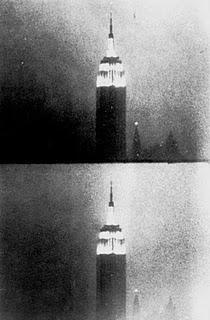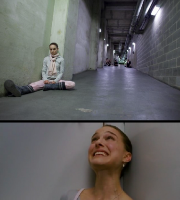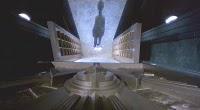
Andy Warhol's Empire, 1964
As I recently sat in a lecture discussing representation and symbolism of architectural utopias in film, my mind was triggered at the mention of Warhol's Empire. No real focus was made of the film if only to reference an instance in which architecture, art and film collided in the ultimate experiment of the chronos of architecture.Something in my consciousness was awakened that day as I zoned out for the rest of the talk and things started almost instantly falling into place: I'd just found the relevance of Chelsea Girls. Unlike Empire, which is essentially the portrait of a monument which is arguably interchangeable with any other object or person while maintaining the same power of documentary, I've come to consider Chelsea Girls a portrait about place.
It was so simple yet hiding in the background. Drugs, sex, alcohol and personality is allowed to develop and unravel within the confines of the Hotel Chelsea. The setting is just as important, or even more so, than the people themselves. The "girls" have no identity separate from place. In a way, I think, it can even be compared to the way in which The Factory, and the Factory's myriad of stars, developed their celebrity in relation to a place.This is not to say that we can't recognize Nico, Ondine or Brigid, because we certainly can. What I want to get at is the idea that the film is not about Nico, or Brigid or Ondine––simply because the film would have been just the same had it Warhol pointed the camera at Baby Jane, Chuck and Billy Name (in fact, take your pick)––the film is about the Hotel Chelsea.
Most interestingly though, is the grander realization I've come to, as the theme of architecture's role in film keeps circling in my mind. For weeks, no film watched (and its been many) has escaped the immediate analysis of connections between built environment and plot.

Darren Arnofsky's Black Swan, 2010
Going back to the lecture, given by architecture professor Dietmar Froelich, films such as The Fifth Element, Fellini's Roma, Antonioni's Zabriskie Point, Godard's Le Mepris and even Citizen Cane can be framed around the use of Architectural Utopias as an avenue to depict human angst, hope, and even societal and technological change.


And then there's Terry Gilliam. Notably absent from the list of films presented, but particularly relevant in the discussion of Architectural Utopias. Unavoidable to this discussion are the oppressive, out-of-scale buildings that intimidate and imprison Sam Lowry in Brazil. There is an excruciating sense of enclosure that builds up throughout the film, developing an environment in which the need to get out is central to the plot.
Neil Brun breaks down the plot line of Brazil through three distinct architectural personalities: The Architecture of Authority, Entrapment and Imprisonment, and Control.
After much research, three major themes have surfaced which I believe to hold the most value for discussion regarding the use of architecture in the film as a comment on the modern age. The first and second are authority and entrapment, and the third is control, which is the goal of the first two.From the moment the film begins Sam is trapped. Whether it is the office, his apartment, the Department of Records, or the torture chamber, the way spaces are enclosed seem to be the method through which Gilliam criticizes modern socio-political ideals and technologies.
A brick monolith comes to life in Sam's dreams and prevents him from flying free with the woman he loves, constantly making it clear that the society in which he's living yields no space for breaking free from the oppressive environment. Ultimately architecture in Brazil represents the complete death of paradise.
So maybe it was left out because it is really about Dystopia?
There is definitely no way I can do justice to Gilliam's role in this discussion with a couple of paragraph of my long-winded thoughts, so maybe sometime soon I'll put together some more coherent thoughts and devote a post just for him. After all, there's also 12 monkeys to discuss within this same framework of Architecture in film, and even Tideland as a pleasant contrast to the grey dystopias described above. But for now, this will have to do:
[Related: Film]
Images via: netkushi,artcritical, imagesjournal.

